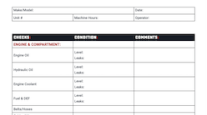E&MU: High-Tech Tracking Keeps Parts Shelves Stocked and Ready
By Mindy Long, Contributing Writer
This story appears in the January/February 2012 issue of Equipment & Maintenance Update, a supplement to the Jan. 23 print edition of Transport Topics. Click here to subscribe today.
To keep their customers’ equipment up and running, truck dealers are increasingly relying on complex algorithms and predictive modeling to maintain inventory levels that will ensure they have the parts truckers need right when they need them, according to dealers and manufacturers.
Most dealers these days keep track of what’s on their shelves by using software that ties into their accounting systems and track inventory by part number as it moves through their shops. But for many dealers, the magic happens when that technology interfaces with software from truck makers that recommends daily orders based on the dealership’s sales history, geographic location, national trends to forecasts expected demand.
“As the dealers sell throughout the day, we collect the data, analyze it and then make recommended purchases at the end of the day.” said Karl Mowat, general marketing manager for truck and engine manufacturer Paccar Inc., Bellevue, Wash. “The following morning, [those recommended products] will be put on a delivery truck. That reduces the lead time to our customers and improves our service level.
The software Paccar uses, Managed Dealer Inventory, has two goals: ensuring required parts are in stock and making the most of dealers’ inventory investments.
“You want to make sure you have everything you need in case there is demand, but at the same time you don’t want to have parts taking up space in your warehouse,” said James Chenier, vice president of aftermarket sales and marketing for Volvo Trucks. The truck maker’s program, Logistic Partnership Agreement, also tracks trends and recommends orders.
Kyle Treadway, president of Kenworth Sales Co., said, “Users across the country give [Paccar’s MDI software] input. As it gathers information, the scope of its data helps it define and ratchet down to a specific number.” Paccar manufactures Kenworth and Peterbilt trucks.
Kenworth Sales, based in West Valley City, Utah, operates 20 branches in mountain and western states. Treadway said the parts department “has become the most critical part” of the company.
OEMs and dealers expressed satisfaction with how the software works.
“We’re running near-perfect inventory replacement figures, which is at an all-time high,” Mowat said. “We have up to six different algorithms the computer is monitoring to react to inventory and get the right part at the right place.”
Software systems also take into account sales based on regional and seasonal differences. Paccar’s MDI identifies geographic locations where dealers should stock additional high-demand parts.
“It may not be a commonly stocked part for that location, but if we have nationwide fleets that need that part, we may make an incremental recommendation,” Mowat said.
Daimler Trucks North America’s software lets dealers enter their customers’ vehicle identification numbers and creates a customized list of critical parts dealers may want to stock.
Jerry Davis, parts manager for Freightliner of New Hampshire, Londonderry, N.H., added his fleet customers’ information into the system to improve the analysis.
“We try to look at what they’re buying and what they have coming in, what their oldest vehicles are and that we have a good array of stock to keep track of their needs,” Davis said.
Nationwide data exchanges also help dealers find the parts they need faster and allow them to look at parts’ availability regionally and nationally.
“In the Southwest, you’re not selling a lot of winter wiper blades, and in northern Canada, they have requirements for daytime running lights, so they run out faster,” said Thom Meehan, director of inventory and supply chain for Navistar Parts.
With Navistar’s system, a dealer can pick up the phone and request a part directly from another dealer or put out an electronic request.
“It puts out a broadcast message that goes out in concentric circles every 30 minutes that gets wider and wider until we get the part,” Meehan said.
Paccar’s roadside assistance program can look into the system so operators can help carriers find the closest parts and service locations. Daimler’s new trucks will have a virtual technician that will identify the issue and communicate with Daimler’s call center to help drivers find dealers with the parts they need.
Dealers using Navistar’s software, called Dealer Inventory Alliance, see an average fill rate slightly more than 98%.
“That means that for 98% of customers that come into the dealer, they have the part they need,” Meehan said.
Davis said that, as a result of MDI, his Freightliner dealership has seen a 50% increase in his overall gain on net sales out the door.
“That is important, especially considering the economy and how tough it is out there,” he said, adding that he buys all of his parts through the system.
Daimler’s MDI also helps Davis ensure he has all the necessary parts to complete a repair.
“I don’t want to keep a truck down because I don’t have a 15-cent gasket that has to go with a $500 pump. By using the MDI, that type of problem has become few and far between,” he said.
Stocking the right inventory and placing small, frequent orders means dealers don’t have to leave capital tied up on their shelves.
“It ends up being the two sides of a teeter-totter — cash management versus customer satisfaction,” Meehan said.
“Instead of having $1.2 million sitting on the shelf, we’ll have $1 million,” Treadway said. “It probably saves us a minimum of 20% of our investments. Those are dollars sitting on our shelves, so the more efficiently we can turn them, the more profit we can generate.”
Chris Craddock, director of service provider WheelTime Exchange, Greensboro, N.C., is tasked with keeping the right inventory at 185 nationwide locations. He said the system helps him keep freight costs down.
“You might be able to get [the part needed through] UPS Ground tomorrow morning for $12 versus overnight air for $125, or it could be 50 miles down the road, and you could pick it up the same day and get the truck running.”
For many dealers and service centers, parts sales have increased in step with fleet ages, making proper management even more important.
“The average age of the truck is now over 12 years old, and the service parts market has been growing double-digits worldwide,” Mowat said.
Craddock said the aging fleets have changed the scope of the business for WheelTime.
“Because we’re diversifying our business [by] reaching out to more and more fleets, and fleets with mixed OEMs, we’re having to diversify our inventory,” Craddock said. “We have to carry a wider breadth of inventory versus depth” — meaning, for example, the company prefers stocking five brake rotors from 10 suppliers rather than 10 brake rotors from five suppliers.
Truck Enterprises Inc., a dealership with six locations in Virginia and one each in West Virginia and Maryland, has expanded its offerings and now services products from many manufacturers, which means it must stock more parts.
“Our product coverage has grown, but our depth has lowered. Instead of stocking 20 clutches, I’ll stock two now because I can get them more often,” said Mike Carwile, parts manager at the Richmond, Va., location of Truck Enterprises — which services Kenworth, Volvo, Isuzu and Hino equipment and uses Paccar’s and Volvo’s software to buy parts.
What’s more, the number of available parts is increasing.
“There are so many more [stock-keeping units] now, you can’t manage it like you used to,” Craddock said, noting that more than 500,000 SKUs have had some type of activity in the past 12 to 18 months. “Out of that, you probably have 50,000 to 60,000 stocking items — and that is growing every day as we diversify our business.”
Paccar has more than a million part numbers on file, but Mowat said the average location carries 15,000 different items.
New environmental regulations also have meant truck models are changing more frequently than they did in the past.
“Models are changing more rapidly, so if dealers wait for that historical data to determine what parts to carry, they’re behind the curve,” said Bob McWilliams, manager of Paragon business support and retail parts availability for Daimler Trucks North America. DTNA, like Paccar, also calls its stock-management software Managed Dealer Inventory.
For its new vehicles, Volvo typically has a mandatory stock list.
“We push parts to the dealer that we deem necessary to support new vehicles out there,” Chenier said. “If you don’t have the history of movement, it is difficult to apply an algorithm to that.”
As time passes, Chenier said, Volvo gets a better idea of the parts needed to service new equipment and adjusts its recommendation.
For dealers, buying parts they’ve never used before can be a risk. But some of that risk is mitigated if dealers participate in the OEM programs that take back a recommended part if it doesn’t sell within a certain period of time.
“Typically when you sign up, you’re signing up for a partnership,” Craddock said. “We’re tying up some money in the short term, but there is no long-term risk.”
For example, Paccar offers reduced freight rates and waives restocking fees if dealers return a part their system recommended. Daimler waives all freight fees.
“What we’re trying to do is just to [urge] them to bring in a broad range of products and have enough safety stock on hand so they never go on back order,” Mowat said.
Paccar, Volvo, Navistar and Daimler’s programs are free, and they don’t carry minimum requirements, but they do offer incentives to dealers that participate at certain levels.
“If we accept a certain amount, then we’re entitled to discounts on certain classes of parts purchases. It is gathering up nickels and dimes, but those equate to quite a bit of money,” Kenworth’s Treadway said.
Dealers that allow Navistar to manage at least 75% of their Navistar parts numbers are eligible to participate in sales incentives programs, Meehan said.
Scott Rice, parts manager for Daigle & Houghton, a dealership with two locations in Maine, buys 98% of Daimler’s recommended products and recently started using Navistar’s system. If Rice has concerns over a part’s availability, he can check the system to see how many are left in the manufacturer’s stock.
“If I see there are only two left in the country, I’ll buy them and put them in inventory,” he said.
Craddock said, “With just-in-time inventory and with everybody trying to run as lean as possible, you cannot afford to have inventory errors.”



